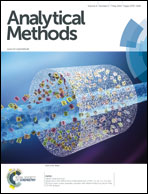A sensitive, switchable and biocompatible surface enhanced Raman scattering-fluorescence dual mode probe using bipyramid gold nanocrystal-gold nanoclusters for high-throughput biodetection†
Abstract
High-throughput biodetection based on optical codes increasingly received significant attention regarding food safety, molecular biology analysis and disease diagnosis. However, the present probe lacks the desired biocompatibility, specificity, sensitivity and code capacity. Here, we reported the synthesis of bipyramid gold nanocrystal-gold nanoclusters (BPGN/GNC) and their application as new dual mode probe for high-throughput biodetection. The hybrid nanoparticles offer excellent biocompatibility owing to the adoption of non-toxic gold nanocrystals, and a strong surface enhanced Raman scattering (SERS) signal of the SERS reporter because of the unique optical and electronic properties of BPGN, which is more than 17-fold that of the probe using gold nanoparticles and 6-fold that of the probe using gold nanorods. The fluorescence and SERS signals of the probe can be separately generated when excited at wavelengths as 365 and 785 nm, which avoids disturbance from each other. The SERS-fluorescence joint spectral encoding method provides a broadened optical spectrum range for efficient encoding as compared to a single SERS or fluorescence-based encoding protocol. Such new concept of an optical encoding approach was successfully applied to simultaneously detect aflatoxin B1, B2, G1, G2, M1 and M2 with ultrahigh sensitivity and specificity. The study also opens a new way in an optical encoding system, which could have enormous potential applications in high-throughout bioanalysis.


 Please wait while we load your content...
Please wait while we load your content...